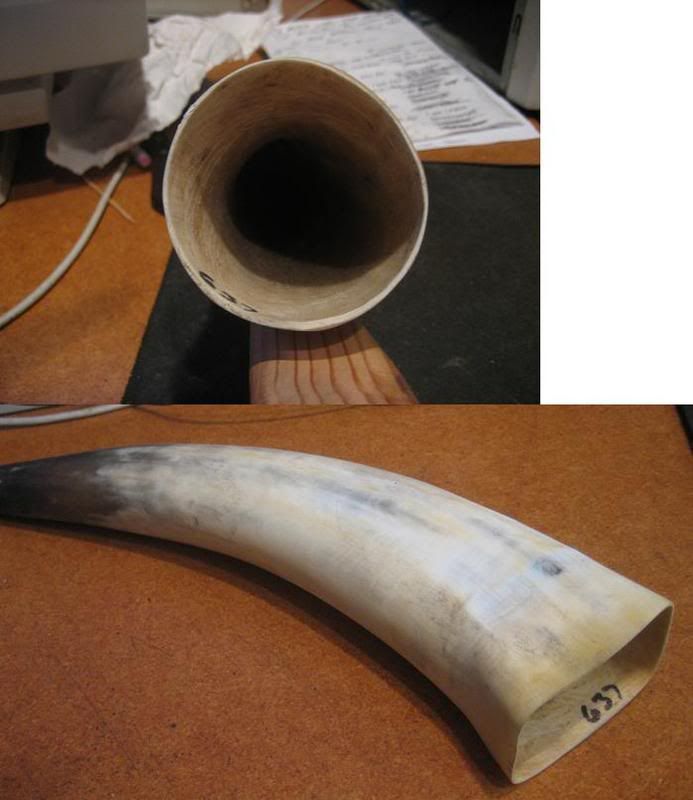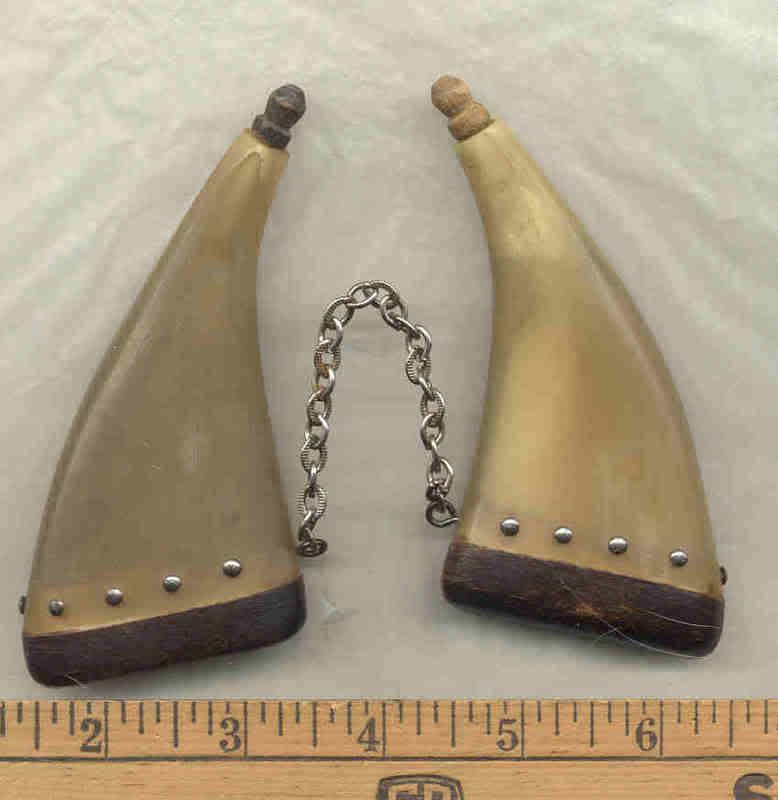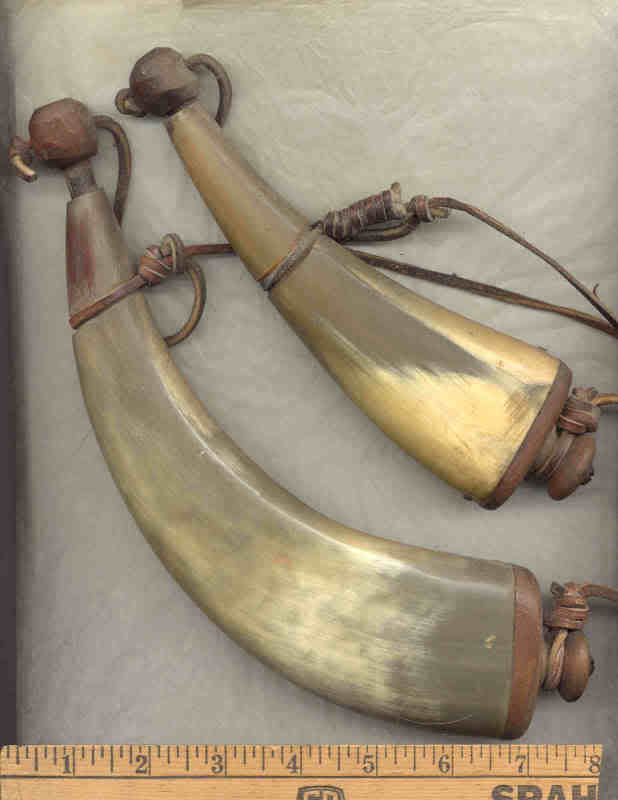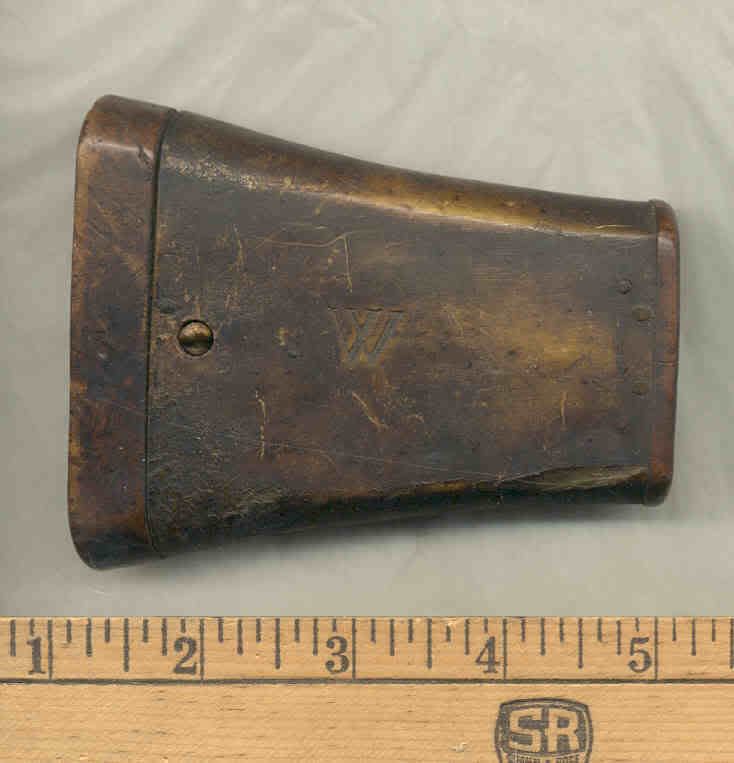I have wanted to flatten a horn and maybe the oil is just the trick. Then clamp the horn between two boards. Has anyone ever tried a standard pressure cooker? That should get the temp. up. I may try it outside this weekend. I cooked down some sheep fat in the house and I never heard the end of it.
You are using an out of date browser. It may not display this or other websites correctly.
You should upgrade or use an alternative browser.
You should upgrade or use an alternative browser.
Flattening the horn
- Thread starter Bert
- Start date

Help Support Muzzleloading Forum:
This site may earn a commission from merchant affiliate
links, including eBay, Amazon, and others.
- Joined
- Jul 7, 2007
- Messages
- 2,657
- Reaction score
- 13
The pressure cooker sounds pretty scary to me!  ...Just put your horn in some 325-350 degree cooking oil for about 5-6 seconds at a time. You only need to stick the horn about half to two thirds way down into the oil, base first...When the base gets flexible, clamp your horn in a vise and slowly clamp it flat. You will need to pre-make you a spacer to put inside the horn while clamping.
...Just put your horn in some 325-350 degree cooking oil for about 5-6 seconds at a time. You only need to stick the horn about half to two thirds way down into the oil, base first...When the base gets flexible, clamp your horn in a vise and slowly clamp it flat. You will need to pre-make you a spacer to put inside the horn while clamping.
Do a search on this forum for other methods and pic's!
I use a HEAT GUN and get the same results...Slower, but less messy and SAFER!
Good luck,
Rick
Do a search on this forum for other methods and pic's!
I use a HEAT GUN and get the same results...Slower, but less messy and SAFER!
Good luck,
Rick

I used the same kind of method Horner 75 did .. though I used hot water and let it soak about 2 hours to make it pliable ... make sure you make an interior wooden wedge shaped plug like he said or it will fold inward on you!, and I wedged mine between two large boards and let it set for a while til it cooled before I continued shaping it! :hatsoff:
Davy
Lead Chucker
32 Cal.
- Joined
- Nov 29, 2007
- Messages
- 38
- Reaction score
- 1
horner75 said:The pressure cooker sounds pretty scary to me!
Just out of curiosity, why? Concern over the safety of pressure cookers in general, or something specific to using it for this purpose?
paulvallandigham
Passed On
- Joined
- Jan 9, 2006
- Messages
- 17,537
- Reaction score
- 94
Even if using a pressure cooker will make the horn pliable, you have so little time to shape the horn to the new shape when you use hot water, or steam, its difficult to do when you consider the time it takes to reduce the pressure to safely take the lid off the pressure cooker, remove the HOT horn, and then put it in the press.
Oil heating the horn will leave oil in the pores of the horn, which helps it remain pliable LOnger, giving you more time to work the antler in your press.
For forming the horn, consider using two pieces of parallel cut lumber, perhaps 1/2 by 3/4 ", with the corners rounded, and then cut another piece of stock that is perhaps 2 inches wide, and how ever long you want, but cut the piece in half so that you have two triangles. That way you can put them in between the two straight, or parallel cut pieces, which will push you out the edges of the horn, and a simply blow or two with a mallet on the wedge on the outside will stabilize the two parallels to any angle needed. If you have an really odd widening angle on one side of the horn, you can make another wedge to use with the first two to push one of the parallels out further. You do need to make a box to control the movement of the horn while the sides are being pressed, and left to dry. If you are planning on doing several flat horns, it would be worth making the box sturdy enough for repeated use. The bottom plate should be thick enough to support verticle poles to guide the top plate down. YOu will want the top plate to be stout enough NOT to warp as you press the horn down. And, you might as well use threaded bolts as the verticle posts, with large washers to protect the holes through the top plate, and turn nuts to crank down the top plate, on at least 3 corners, if not all 4. That horn is going to want to squirt out towards the base, and when you get it flattened, perhaps towards the spout end. You need to have some kind of shoulder around the outer edge of the box, tall enough to prevent the horn from squeezing out, but not so tall as to interfere with the vise operation of the box to flatten the horn. Of course, for a faster, one time effort, you can use C-clamps,and Parallel clamps, but that means you have to act faster, and you will probably need the help of someone to help you set the clamps while one of you holds the horn from moving away from where the pressure is being applied by the other.
Oil heating the horn will leave oil in the pores of the horn, which helps it remain pliable LOnger, giving you more time to work the antler in your press.
For forming the horn, consider using two pieces of parallel cut lumber, perhaps 1/2 by 3/4 ", with the corners rounded, and then cut another piece of stock that is perhaps 2 inches wide, and how ever long you want, but cut the piece in half so that you have two triangles. That way you can put them in between the two straight, or parallel cut pieces, which will push you out the edges of the horn, and a simply blow or two with a mallet on the wedge on the outside will stabilize the two parallels to any angle needed. If you have an really odd widening angle on one side of the horn, you can make another wedge to use with the first two to push one of the parallels out further. You do need to make a box to control the movement of the horn while the sides are being pressed, and left to dry. If you are planning on doing several flat horns, it would be worth making the box sturdy enough for repeated use. The bottom plate should be thick enough to support verticle poles to guide the top plate down. YOu will want the top plate to be stout enough NOT to warp as you press the horn down. And, you might as well use threaded bolts as the verticle posts, with large washers to protect the holes through the top plate, and turn nuts to crank down the top plate, on at least 3 corners, if not all 4. That horn is going to want to squirt out towards the base, and when you get it flattened, perhaps towards the spout end. You need to have some kind of shoulder around the outer edge of the box, tall enough to prevent the horn from squeezing out, but not so tall as to interfere with the vise operation of the box to flatten the horn. Of course, for a faster, one time effort, you can use C-clamps,and Parallel clamps, but that means you have to act faster, and you will probably need the help of someone to help you set the clamps while one of you holds the horn from moving away from where the pressure is being applied by the other.
Lead Chucker
32 Cal.
- Joined
- Nov 29, 2007
- Messages
- 38
- Reaction score
- 1
paulvallandigham said:Even if using a pressure cooker will make the horn pliable, you have so little time to shape the horn to the new shape when you use hot water, or steam, its difficult to do when you consider the time it takes to reduce the pressure to safely take the lid off the pressure cooker, remove the HOT horn, and then put it in the press.
I understand what you are saying, but pressure cookers have come a long way... the one I use for cooking can be safely depressurized in just a few seconds.
BTW: I'm not arguing whether it's really a good way to soften a horn, as I have no idea.
paulvallandigham
Passed On
- Joined
- Jan 9, 2006
- Messages
- 17,537
- Reaction score
- 94
Glad to hear it. I just don't like steaming horn, which is like your finger nails. It seems to dry out any remaining oils and makes them brittle, and prone to cracks and splits. Using hot oil just seems to be the better way to do this.
I boiled a couple of horns, and still have them.The never got soft enough to flatten. But they sound like old dried out nails, and I am definitely going to heat them in cooking oil the next time I try to get them soft enough to flatten.
I boiled a couple of horns, and still have them.The never got soft enough to flatten. But they sound like old dried out nails, and I am definitely going to heat them in cooking oil the next time I try to get them soft enough to flatten.
ladysmithtrading
40 Cal.
- Joined
- Sep 27, 2005
- Messages
- 485
- Reaction score
- 0
Paul, sounds like you have a press like the one we just built.
- Joined
- Jul 7, 2007
- Messages
- 2,657
- Reaction score
- 13
My comment was along the thinking of him trying to use oil in a pressure cooker! Boiling water will not work in every situationLead Chucker said:horner75 said:The pressure cooker sounds pretty scary to me!
Just out of curiosity, why? Concern over the safety of pressure cookers in general, or something specific to using it for this purpose?
I used my vise to flatten several horns. I cut two boards to use on either side of the horn when in the vice. And I then made a "wedge" on the back of one board so that the flat sides of my horn would taper from the tip out to the end. Otherwise, the flat sides on my horn would have been parallel. I did not use an inside plug. This gave me nice flat sides on my horn, but kept those flats pretty much in a line tapering/flaring out from the tip to the butt.
I also carved a slight depression in each board - so that the flat sides of my horn would have a gentle curve - instead of being true flat. The combination of that taper/flare from tip to butt, and the sides being ever so slightly rounded, gave me a more pleasant look.
For heating, I used my microwave oven. I got everything lined up first, of course. I then put my horn in the microwave on an old plate - and zapped it for a few seconds. I then rotated it or turned it over and zapped it for a few more seconds. Never more than 5 or 10 seconds at any one time. And the rotating turntable also helped. You have to be very careful about getting "hot spots". If any area gets too hot, it "cooks" the horn - it starts to look like it was deep fat fried. And that "cooked" area is lost. You just can't rejuvinate it. In under a minute total time (depending upon the size of your horn) it will be hot enough to flatten. You will need to use a glove to pick it up - even when doing the heating.
This worked for me. Other people's experiences may vary.
But this does remind me of another project I have to get back to. I need to cut some sections from a Texas Longhorn, and flatten them into sheets. And then put those sheets into a candle lantern in place of the glass - to make a very early version of a candle lantern called a Lathorn.
And then there's that triangular lantern designed to have a Betty Lamp or Grease Lamp clipped into a bracket inside it. Hmmm ... more projects.
Just my humble thoughts to share. Take them as such.
Mikey - yee ol' grumpy German blacksmith out in the Hinterlands
I also carved a slight depression in each board - so that the flat sides of my horn would have a gentle curve - instead of being true flat. The combination of that taper/flare from tip to butt, and the sides being ever so slightly rounded, gave me a more pleasant look.
For heating, I used my microwave oven. I got everything lined up first, of course. I then put my horn in the microwave on an old plate - and zapped it for a few seconds. I then rotated it or turned it over and zapped it for a few more seconds. Never more than 5 or 10 seconds at any one time. And the rotating turntable also helped. You have to be very careful about getting "hot spots". If any area gets too hot, it "cooks" the horn - it starts to look like it was deep fat fried. And that "cooked" area is lost. You just can't rejuvinate it. In under a minute total time (depending upon the size of your horn) it will be hot enough to flatten. You will need to use a glove to pick it up - even when doing the heating.
This worked for me. Other people's experiences may vary.
But this does remind me of another project I have to get back to. I need to cut some sections from a Texas Longhorn, and flatten them into sheets. And then put those sheets into a candle lantern in place of the glass - to make a very early version of a candle lantern called a Lathorn.
And then there's that triangular lantern designed to have a Betty Lamp or Grease Lamp clipped into a bracket inside it. Hmmm ... more projects.
Just my humble thoughts to share. Take them as such.
Mikey - yee ol' grumpy German blacksmith out in the Hinterlands
Lead Chucker
32 Cal.
- Joined
- Nov 29, 2007
- Messages
- 38
- Reaction score
- 1
horner75 said:My comment was along the thinking of him trying to use oil in a pressure cooker! Boiling water will not work in every situationLead Chucker said:horner75 said:The pressure cooker sounds pretty scary to me!
Just out of curiosity, why? Concern over the safety of pressure cookers in general, or something specific to using it for this purpose?
Ok, thanks for the response. It sounds like many consider oil to be an important part of the process - for more than just the heat. Good to know!
Here's a pic of a salt and pepper horn set a friend made. They have those slightly rounded sides, and still taper/flare a bit from the tip to the end plugs. The lighter color horn helps you see the level of the contents when held up to the light. And, of course, those colored pegs let you know what you are going to shake out.

Here's a pic of two flattened horns that I traded for over two decades ago. They have those classic flat/parallel sides.

And here's a pic of an original flattened horn. It was probably used for shot. The base plug is held on by that one big peg that goes all the way through - so it can be pulled and the bottom removed to fill the horn. Might even have been used for small caliber roundballs. The spout is missing. The rectangular hole where it fit in is still there, including the two brass pins that held it in the top. The sides are just slightly rounded - not quite true flat. But both wood ends are the same width. It's a little hard to make out, but it has that fancy capital letter W carved into the middle of it. It's sometimes amazing what you can find in a "junk" box at a farm auction. Who knows how it ever ended up on that old farmstead.

Mikey - yee ol' grumpy German blacksmith out in the Hinterlands

Here's a pic of two flattened horns that I traded for over two decades ago. They have those classic flat/parallel sides.

And here's a pic of an original flattened horn. It was probably used for shot. The base plug is held on by that one big peg that goes all the way through - so it can be pulled and the bottom removed to fill the horn. Might even have been used for small caliber roundballs. The spout is missing. The rectangular hole where it fit in is still there, including the two brass pins that held it in the top. The sides are just slightly rounded - not quite true flat. But both wood ends are the same width. It's a little hard to make out, but it has that fancy capital letter W carved into the middle of it. It's sometimes amazing what you can find in a "junk" box at a farm auction. Who knows how it ever ended up on that old farmstead.

Mikey - yee ol' grumpy German blacksmith out in the Hinterlands
I can't say what others use, but I have been using canola oil. I'm sure other types of cooking oil would be just as good. Heat the oil to between 325F-350F, shut of your source of heat and put the butt of the horn in the oil for 5 to 8 seconds, take it out and try it to see if it's plyable (wear gloves) if it's not flexable enough put it back in the oil for another 5-8 seconds and try again. when it's soft enough to shape insert your form and let it cool. Once cool the horn should retain it's new shape.Heinrich said:What is the ideal type of oil?
What temperature do you propose, and how long should the horn be submerged??
If you let your oil get too hot or leave the horn in too long it will cook it and become brittle and turn yellowish/orange ( Don't ask me how I know this :redface: :redface: )
Soggy
Similar threads
- Replies
- 1
- Views
- 714
- Replies
- 25
- Views
- 2K
- Replies
- 4
- Views
- 963
- Replies
- 4
- Views
- 1K




